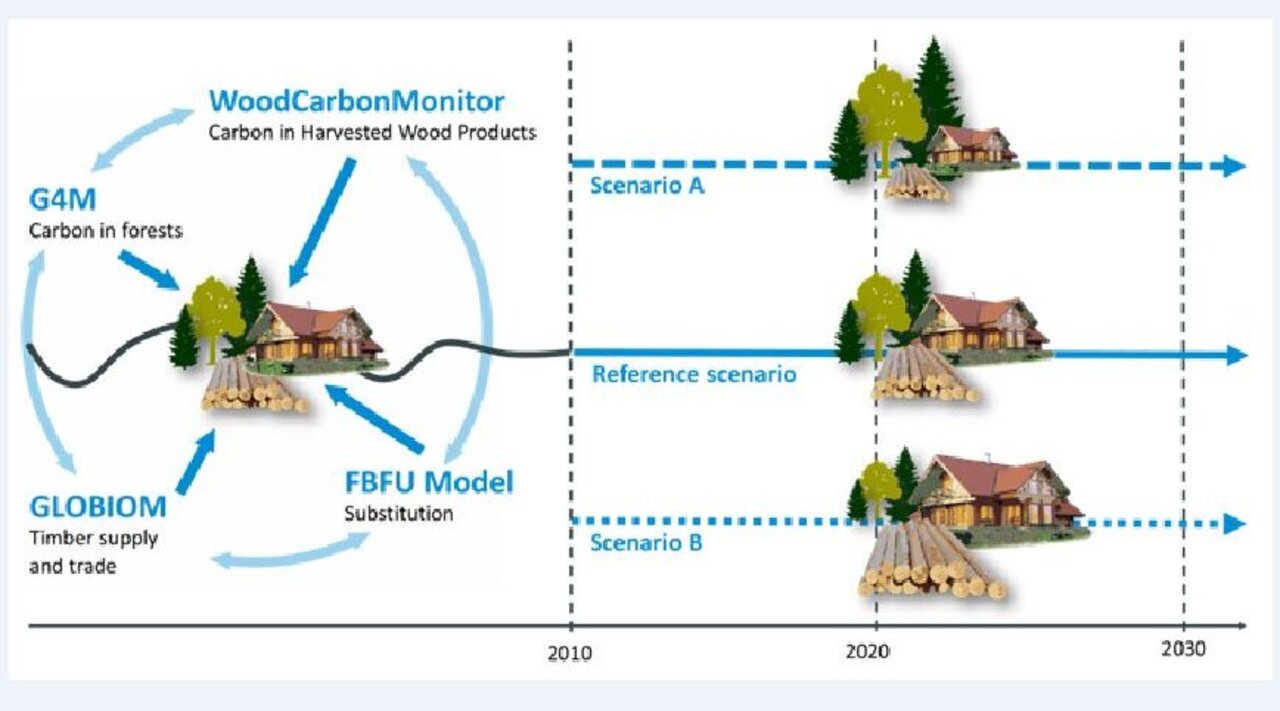Project
Scenarios for optimizing the contribution of the forest-based sector within the EU to climate protection by 2030 (ClimWood2030)

Climate benefits of material substitution by forest biomass and harvested wood products: Perspective 2030
The forest-based sector in the European Union can significantly contribute to climate protection. On the basis of scenarios we show how this contribution to climate protection could be increased and put the results into a policy context.
Background and Objective
The European Union (EU) is committed at the highest level to climate change mitigation and has set targets to reduce greenhouse gas emissions and to use resources efficiently. Also the forest-based sector can help to achieve climate protection goals. In this context, one challenge is to find the best combination of policies for the forest-based sector. There are interactions between these effects, which were very difficult to compare and quantify so far.
The objective of the study 'ClimWood2030' is to assess possible implications of different options of forest management and the use of wood in the EU-28 to contribute to mitigate climate change: in EU and non-EU forests, in harvested wood products and by substituting more emissive materials and sources of energy. On this basis, appropriate policy recommendations should be developed.
Approach
In order to answer the stated goals and research questions, in this European joint project various policy scenarios have been examined based on a series of interlocking models involving all relevant stakeholders in Europe (forest owners, forest-based industries, environmental organizations and politics). The five assessed scenarios include the 'ClimWood2030 reference' scenario (I), 'Increase forest stock in existing EU forests' (II), 'Cascade use – increase recovery of solid wood products' (III), 'Cascade use – prevent first use of biomass for energy' (IV) and 'Strongly increase material wood use' (V). A description of possible policy instruments completes the calculation of the climate change mitigation potential of these alternative scenarios. In this way, the policy can be shown various options for action to improve the climate protection performance of the European forestry and wood sector.
Data and Methods
For estimating the GHG balances of the scenarios, established models of the project partners were combined. The Global Forest Model G4M (IIASA) determines the growth of the forests, the biogenic carbon storage effect as well as the potential timber harvest amounts. The global equilibrium model GLOBIOM (IIASA) maps the area competition between agriculture, bioenergy and the forestry sector. It allows statements on the appropriate use of biomass for example in wooden houses or for energy. By means of the model WoodCarbonMonitor (Thünen-Institut) we calculate the bioenic carbon storage effect of the material wood use. By linking these datasets with standard-compliant life cycle assessment information on the different uses of wood and the respective competing products made of other raw materials, the potential energetic and material substitution effects of the scenarios of a changed wood usage in Europe could be estimated.
Our Research Questions
What are the impacts of different policy strategies on the carbon stocks in forests and harvested wood products inside and outside the EU?
What are the indirect effects of an increased use of wood at the expense of goods that require more energy for their production (material substitution)?
Which indirect effects are caused by a change in the use of timber, forest residual or waste wood as fuel (energy substitution)?
Results
The analysis of ClimWood2030 has demonstrated the complexity of the dynamics of the forest based sector’s greenhouse gas balances, and sometimes counterintuitive consequences of policy choices. It has also shown that action on one part of the EU forest-based sector has consequences in other parts of the sector within the EU as well as in other parts of the world. The main recommendation should therefore be to consider carefully the complex consequences of the policy choices, over the short and the long term and for all actors and all carbon flows and pools and for all aspects of sustainable forest management, including biodiversity, employment and livelihoods.
Thünen-Contact

Funding Body
-
European Union (EU)
(international, öffentlich)








